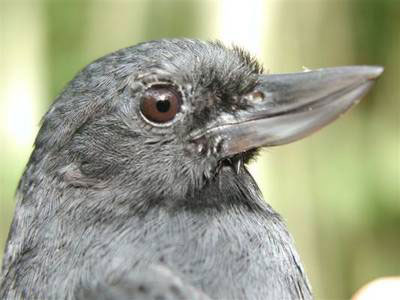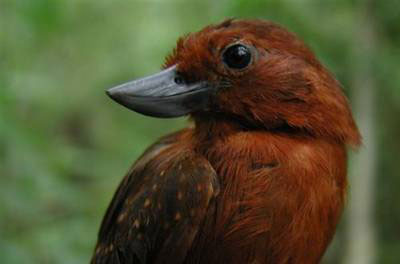Rediscovering the 'Smiling Bird'

Recurve-billed Bushbird: The 'Smiling bird'. A male Recurve-billed Bushbird (photo: Chris Sharpe/Provita).
A string of recent sightings of one of South America's most unusual and secretive birds is giving conservationists hope in regional efforts to save crucial habitat for this and other threatened species.
Having not been seen for over 40 years, hope was fading for Recurve-billed Bushbird. However, successive sightings from Venezuela in 2004, and then Colombia in 2005 and 2007, have led to renewed efforts to understand the distribution of a bird feared extinct by many. With a distinctive up-turned bill, this species gives the impression of having an enigmatic smile; however, it has evolved to forage in the inner parts of bamboo, a habitat which is now under severe threat.
"These sightings really underline the importance of survey efforts: how one observation can be the starting point from which a bird - long thought extinct - can be brought back, and hopefully saved by site-based conservation efforts," said Rob Clay, BirdLife International's Americas Conservation manager.

Recurve-billed Bushbird: Female Recurve-billed Bushbird (photo: Chris Sharpe/Provita).
In 2004, a four-man Rapid Assessment Programme team organised by Venezuela Audubon and the Phelps Collection and financed by Conservation International was the first to come face-to-face with the bird in the Venezuelan foothills of Sierra de Perijá. Shortly afterwards, in July 2005, two individuals were found in Agua de la Virgen, Santander, Colombia.
"The local farmers were crucial to our fieldwork as they were the first observers of the bushbirds. It goes to show how important it is to include local knowledge in these kinds of surveys," said Chris Sharpe of Provita, part of the team which originally rediscovered the species.
The most recent sighting of Recurve-billed Bushbird came in April of this year in the central Andes of Colombia, a new locality with no previous records. Gabriel Colorado, the ornithologist who made the observations was working on bird surveys in dry forests for the regional environmental authority CORANTIOQUIA. This area is not only threatened by deforestation but also by the possible construction of the Pescadero-Ituango hydroelectric dam, on the Cauca River. If approved, the dam will be constructed in the next few years, and the area flooded.
Gabriel Colorado said "We are now able to explore and survey areas that were once politically unstable, allowing us to learn more about the distribution of this and other rare species. Unfortunately, many threats exist for this new population, meaning we must act now in order to save it".
To find more similar stories, why not subscribe to BirdLife International's World Birdwatch magazine?

